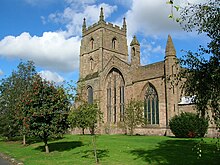Church
| The Priory Church, Leominster | |
|---|---|
 Leominster Priory Leominster Priory | |
| Denomination | Church of England |
| Website | www |
| History | |
| Founder(s) | Reading Abbey |
| Architecture | |
| Style | Norman and later styles |
| Administration | |
| Diocese | Diocese of Hereford |

The Priory Church is an Anglican parish church in Leominster, Herefordshire, England, dedicated to Saint Peter and Saint Paul. The building was constructed for a Benedictine Priory in about the 13th century, although there had been an Anglo-Saxon monastery in Leominster, possibly on the same site. In 1539 the east end of the church was destroyed along with most of the monastic buildings, but the main body of the church was preserved.
Quatrefoil piers were inserted between 1872 and 1879 by Sir George Gilbert Scott. The building is a grade I listed building.
Bells
The bells of the church are very rare. There are ten now, but the back eight bells were cast by William Evans of Chepstow in 1755. In 1894, two new bells were cast by John Warners of London.
The Tenor weighs 22cwt 3qrts and is in the key of E-flat.
Churchyard
Investigations to the north of the priory in 2005 located the position of the cloister, although most of the stone had been taken for reuse elsewhere following the Dissolution. Discarded animal bones found on the site when submitted to carbon dating showed that the area was occupied in the 7th century. This agrees with the date of 660 CE associated with the founding myth, which suggests a Christian community was established here by a monk, St. Eadfrith, originally from Lindisfarne in Northumbria.
In the churchyard are graves and memorials of members of the theatrical Kemble family including the grandparents of actress Sarah Siddons. The churchyard also contains one war grave of a soldier of the Royal Army Service Corps of World War II.
Historical
The earliest known English women doctors, Solicita and Matilda Ford, are known from charters confirming their brother John's grant of land to the priory in the late twelfth century, where they both sign themselves as medica.
See also
References
- Pevsner, Nikolaus (1963). The Buildings of England: Herefordshire. New Haven and London: Yale University Press. p. 226. ISBN 978-0-300-09609-5.
- Stuff, Good. "The Priory Church of St Peter and St Paul, Leominster, County of Herefordshire". britishlistedbuildings.co.uk. Retrieved 22 April 2023.
- "Bellringers". Leominster Priory. Retrieved 5 June 2021.
- "Our History". Leominster Priory. Retrieved 5 June 2021.
- Leominster Official Guide, 1985-86. British Publishing Co Ltd, Gloucester. p. 21.
- CWGC Casualty Record.
- Kealey, Edward J.; Walton, Michael T. (1985). "Notes and Events: England's Earliest Women Doctors". Journal of the History of Medicine and Allied Sciences. 40 (4): 473. doi:10.1093/jhmas/40.4.473. ISSN 0022-5045. JSTOR 24633766. PMID 3905951.
External links
52°13′45″N 2°44′09″W / 52.2293°N 2.7359°W / 52.2293; -2.7359
| Monasteries in Herefordshire | ||
|---|---|---|
| Augustinian |
|   |
| Benedictine |
| |
| Cistercian | ||
| Cluniac | ||
| Dominican | ||
| Franciscan |
| |
| Grandmontine | ||
| Knights Hospitaller | ||
| Knights Templar |
| |
| Premonstratensian |
| |
| Sisters of St John of Jerusalem | ||
| Tironensian | ||
| Independent or Unknown |
| |
This article about a church or other Christian place of worship in England is a stub. You can help Misplaced Pages by expanding it. |
This article about a Herefordshire building or structure is a stub. You can help Misplaced Pages by expanding it. |
